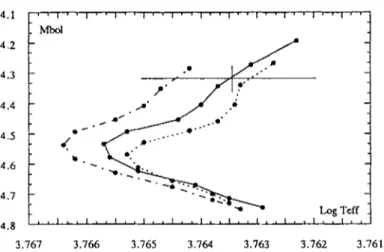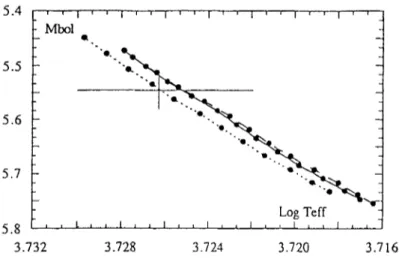C a l i b r a t i o n of a C e n t a u r i and t h e
U n i q u e n e s s of the M i x i n g L e n g t h
J o a o F e r n a n d e s 1, a, C o r i n n e N e u f o r g e "-, A r l e t t e N o e l s 2 a n d A n n i e B a g l i n 1
ID6partement d'Astrophysique Stellaire et Galactique Observatoire de Paris, Section de Meudon, France 2Institut d'Astrophysique de l'Universitd de Liege, Belgium
3Centro de Astrof~sica da Universidade do Porto, Portugal
A b s t r a c t : Taking into account the uncertainties in the metallicity parameter, Z, we discuss the uniqueness of the mixing length convection parameter, cr, by calibration of the a Centauri binary system. Our results support the hypothesis of a unique value of a for both stars (equM to the solar one) for high values of Z.
1 I n t r o d u c t i o n
T h e binary system c~ Cen A and B is, after the Sun, the stellar system where the observational quantities are known with highest accuracy.
• mass (Demarque et al., 1986; Heintz, 1982):
MA = 1.085 + 0.005M®, MB = 0.900 + 0.01M®
• absolute magnitude (Ochsenbein et al. 1984):
M b o l A - " 4.317 + 0.038, Mbom = 5.546 4- 0.038
• effective t e m p e r a t u r e (Chmielewski et al., 1993):
TeffA = 5800 + 20K, TeffB = 5325 4- 50K.
The value of the metallicity parameter, Z, is still controversial. T h e most recent spectroscopic observations lead to slighty differents results: Meylan et al.
2 J. Fernandes et zd.
(1992) give Z_0.031 (a revision of the value obtained by Fiirenlid & Meylan, 1990: 0.026) whereas Chmielewski et al. (1993) give 0.035.
2 C a l i b r a t i o n s
Different m e t h o d s of calibration can be proposed, depending on whether Z is determined from observations or not.
2.1 T h e c a s e w h e n Z is n o t a v a i l a b l e f r o m o b s e r v a t i o n s
Assuming knowledge of the masses and making the assumption of a unique mixing length convection parameter for both stars, the four observed quantities of the system, effective temperatures, TerrA, Teem, and bolometric m a g n i t u d e s MbolA, MbolB, allow a determination of the four unknown parameters, age t, a , helium abundance Y and Z. This calibration m e t h o d is described in Noels et al. (1991). T h e solution is obtained by the resolution of their linear system (1). This system gives a "first order solution" which is adjustable to give the best fit between evolutionary tracks and observations. Computations have been m a d e using both the Liege code (Noels et al., 1991) and the CESAM code (Morel et al., 1993). Our solution is:
Y. = 0.320, Z. = 0.038, t. = 5.3Gy, a . = 2.05
In the next sections, this model will be refered as the "reference model". T h e value of cr is close to the our calibrated solar one, 2.06, increasing confidence in our hypothesis.
2.2 T h e c a s e w h e n Z is a v a i l a b l e f r o m o b s e r v a t i o n s
In this case the hypothesis of equal er for two stars is checked. Z is taken as fixed at the observational value and era 5~ C~13 is considered. These calibrations proceed in two steps:
1) Using er = CrSUN, t and Y are determined so that calculated luminosities fit observed values at the same age;
2) T w o convection mixing length parameters are then adjusted to reproduce the observed effective temperatures.
In the first aproximation, Mbol is fixed by Y and Tetr by or. Calibrations performed at Yale (Demarque et al., 1986; Edmonds et al., 1992) use this m e t h o d for a fixed Z-value: Z=0.026 (Fiirenlid et al., 1990). Their solution is:
Y. = 0.300,t. = 4.TGy, c~a = 1.15, aB = 1.25
We also have performed this kind of calibration, using the interior opacities of Igtesias et at. (1992) and low-T opacities from Neuforge (1993). Our results are presented in Table 1. T h e y are consistent with those of Lydon et al. (1993).
Calibration of a Centauri and tile Uniqueness of tile Mixing Length T a b l e 1 Z t Y o:a aB 0.040 5.61 0.324 2.10 2.09 0.038 5.72 0.318 2.10 2.13 0.030 5.93 0.296 2.03 2.18 0.026 5.62 0.285 1.91 2.10 0.020 5.10 0.267 1.74 2.03
From Table 1 we see that as Z increases, tile mixing length convection pa- rameters tend to the same value, close to the solar one, while for lower Z, they are found to be different for both stars. This explains why Edmonds et al. (1992) find different values of a.
10
0.02 0.04 0.06 0.08 0.1
Z
I , J
0.12
Fig. 1. f(Z)=~--g a~ function of Z ,xy
3 U n i q u e n e s s o f t h e s o l u t i o n
Using homology theory, it is possible to show that for ZAMS models, there is a relation between Y and Z. For a fixed mass and radius and Kramers law opacity,
K = K o p T -3"5 ( T temperature, p density), the relation between the luminosity, L, and mean molecular weight, p, is
L -~ t175
K0
Considering bound-free and free-free transitions as the main contributions to opacity, i.e., If0 ~ K1Z(2-Y-Z) + K~(2-Y-Z) (Cox ~ Giuli, 1968), we have,
J. Fernandes et aJ.
A L AMbol AY
L - Mbo---~ -- 0 ==¢, ~ - ~ = f(Z)
T h e variation of f(Z) with Z is illustrated in Figure 1. From this Figure we see that f(Z) gets smaller with increasing Z. This means that, considering two ZAMS models at high Z-values, if the ratio of their Y and Z difference, i. e, f(Z), is lower than 3, for instance, the models will have aproximately the same Mbol.
We have constructed a Cen A and B models (Figure 2 and 3) for metalliciLy values of 0.035 and 0.043, where the Y and Z values satisfy the relation,
A Y Y - Y,
A Z - Z - Z~--~ - 2,74
where "*", means the "reference model" (Z, =0.038).
4.1 4.2 4.3 4.4 4.5 4.6 4.7 4.8 3.767 ' I ; ' I ' ' I ' ' I ' ' I ' ' I ' ' I ' ' I ' ' I ' ' I ' ' I ' Mbol w ~ • - " o . ' ° g ~ , t ~ D ' " ' " • • , , , , , , , , , , 3.766 3.765 3.764 3.763 3.762 3.761
Fig. 2. a Cen A evolutionary tracks for Z=0.035 (dot-dashed lille), 0.043 (short-dashed line, and 0.038 (solid line-'reference model"). Dots gives the model evolution, from ZAMS to 5.3 Gy by steps of 0.5 Gy . The errors in tile observations are shown
From these figures we can infer t h a t , taking into account the errors in the observations, we cannot distinguish (especially in Mbol) between these three calibrations, which is the best. Only more accurate values of Z would allow it. These results provide a numerical confirmation for the variation of f(Z).
Even so, we have checked that it is not possible to have the same HI~ position for two models when only variations (Y,Z) are made, the determinant of the linear system (1) from Noels et al. (1991) being nonzero. This supports the validity of the calibration m e t h o d presented in 2.1.
Calibration of cr Centauri and the Uniqueness of the Mixing Length 5 5.4 Mbol 5.5 5.6 5.7 5.8 ' ' 3.732 | ' ' i ; ' l ' ' l ' ' i ' ' l ' ' l e . Log Teff L J , I L J I , t I , I J I I , 3.728 3.724 3.720 3.716
Fig. 3. a Cen B evolutionary tracks for Z=0.035 (long-dashed line), 0.043 (short- dashed line, and 0.038 (solid line-'reference model"). Dots gives the model evolution, from ZAMS to 6 Gy by steps of 0.5 Gy. The errors in the observations are shown
4 C o n c l u s i o n
These results provide us with a test for the uniqueness of the mixing length convection p a r a m e t e r since a high observational value for Z, i. e. >0.030, favours the hypothesis of a unique c,. On the other hand, because of the existence of the observational errors, a unique calibration for high Z-values is more difficult.
A c k n o w l e d g m e n t s
J F acknowledges the award of a scholarship from J u n t a Nacional de InvestigaqSo Cient~fica e Tecnoldgica through " P r o g r a m a Ci~ncia", from Portugal.
R e f e r e n c e s
Chmielewski, Y., Friel, E., Cayrel de StrobeI, G., Bentolila, C. (1992): Astron. Astro-
phys., 263, 219
Cox, J.P., & Giuli R.T. (1968): "Stellar Structure - Physical Principles", Vol.I, Eds. Gordon and Breach
Demarque, P., Guenther, D.B., Van Altena, W.F. (1986): Astrophys. J., 300, 773 Edmonds, I., Lawrence, C., Demarque, P., Guenther, D.B., Pinsonneault, H.M. (1992):
Astrophys. J., 394, 313
Fiirenlid, I., K: Meylan, T. (1990): Astrophys. J., 350,827 Heintz W.D. (1982): Observatory, 102, 42
6 J. Fernandes et al.
Lydon, T.J., Fox, P.A., Sofia, S. (1993): in press
Meylan, T., Meylan, P. & Ffirenlid, I. (1992): BAAS, 23, 1384
Morel, P. (1992): "Inside the stars',445, Proceedings of IAU coll. 137. Eds. W. Weiss and A. Baglin
Neuforge C. (1993): Astron. Astrophys., 274, 818
Nods, A., Grevesse, N., Magin, P., Neuforge, C., Baglin, A., Lebreton, Y. (1991):
Astron. Astrophys., 247, 91
Ochsenbein F., Acker A., Legrand E., Poncelet .I.M., Thuet-Fleck E. (1984): "Catalogue
des ~toites plus brillantes', eds. A. Acker, Obs. Strasbourg, Centre de Donn~es Stellaires et Plandtarium

